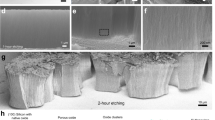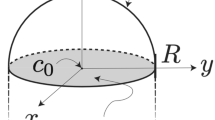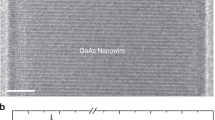Abstract
Interest in nanowires continues to grow, fuelled in part by applications in nanotechnology1,2,3,4,5. The ability to engineer nanowire properties makes them especially promising in nanoelectronics6,7,8,9. Most silicon nanowires are grown using the vapour–liquid–solid (VLS) mechanism, in which the nanowire grows from a gold/silicon catalyst droplet during silicon chemical vapour deposition10,11,12,13. Despite over 40 years of study, many aspects of VLS growth are not well understood. For example, in the conventional picture the catalyst droplet does not change during growth, and the nanowire sidewalls consist of clean silicon facets10,11,12,13. Here we demonstrate that these assumptions are false for silicon nanowires grown on Si(111) under conditions where all of the experimental parameters (surface structure, gas cleanliness, and background contaminants) are carefully controlled. We show that gold diffusion during growth determines the length, shape, and sidewall properties of the nanowires. Gold from the catalyst droplets wets the nanowire sidewalls, eventually consuming the droplets and terminating VLS growth. Gold diffusion from the smaller droplets to the larger ones (Ostwald ripening) leads to nanowire diameters that change during growth. These results show that the silicon nanowire growth is fundamentally limited by gold diffusion: smooth, arbitrarily long nanowires cannot be grown without eliminating gold migration.
This is a preview of subscription content, access via your institution
Access options
Subscribe to this journal
Receive 51 print issues and online access
$199.00 per year
only $3.90 per issue
Buy this article
- Purchase on Springer Link
- Instant access to full article PDF
Prices may be subject to local taxes which are calculated during checkout




Similar content being viewed by others
References
Huang, Y. et al. Logic gates and computation from assembled nanowire building blocks. Science 294, 1313–1317 (2001)
Duan, X., Huang, Y., Cui, Y., Wang, J. & Lieber, C. M. Indium phosphide nanowires as building blocks for nanoscale electronic and optoelectronic devices. Nature 409, 66–69 (2001)
Duan, X., Huang, Y. & Lieber, C. M. Nonvolatile memory and programmable logic from molecule-gated nanowires. Nano Lett. 2, 487–490 (2002)
Cui, Y., Zhong, Z., Wang, D., Wang, W. U. & Lieber, C. M. High performance silicon nanowire field effect transistors. Nano Lett. 3, 149–152 (2003)
Wu, Y. et al. Controlled growth and structure of molecular-scale silicon nanowires. Nano Lett. 4, 433–436 (2004)
Lauhon, L. J., Gudiksen, M. S., Wang, D. & Lieber, C. M. Epitaxial core-shell and core-multishell nanowire heterostructures. Nature 420, 57–61 (2002)
Björk, M. et al. One-dimensional heterostructures in semiconductor nanowhiskers. Appl. Phys. Lett. 80, 1058–1060 (2002)
Björk, M. et al. One-dimensional steeplechase for electrons realized. Nano Lett. 2, 87–89 (2002)
Gudiksen, M. S., Lauhon, L. J., Wang, J., Smith, D. C. & Lieber, C. M. Growth of nanowire superlattice structures for nanoscale photonics and electronics. Nature 415, 617–620 (2002)
Wagner, R. S. & Ellis, W. C. Vapor-liquid-solid mechanism of single crystal growth. Appl. Phys. Lett. 4, 89–90 (1964)
Wagner, R. S. in Whisker Technology (ed. Levitt, A. P.) 47–119 (Wiley- Interscience, New York, 1970)
Givargizov, E. I. Fundamental aspects of VLS growth. J. Cryst. Growth 31, 20–30 (1975)
Law, M., Goldberger, J. & Yang, P. Semiconductor nanowires and nanotubes. Annu. Rev. Mater. Res. 34, 83–122 (2004)
Tromp, R. M. & Reuter, M. C. Design of a new photoemission/low-energy electron microscope for surface studies. Ultramicrosccopy 36, 99–106 (1991)
Nagao, T. et al. Structural phase transitions of Si(111) - √(3) × √(3) - R30°-Au: Phase transitions in domain-wall configurations. Phys. Rev. B 57, 10100–10109 (1998)
Zhang, H. M., Balasubramanian, T. & Uhrberg, R. I. G. Core-level photoelectron spectroscopy study of the Au/Si(111) 5 × 2, α - √(3) × √(3), β - √(3) × √(3), and 6 × 6 surfaces. Phys. Rev. B 65, 035314 (2001)
Yagi, K. Reflection electron-microscopy—studies of surface structures and surface dynamic processes. Surf. Sci. Rep. 17, 305–362 (1993)
Stolwijk, N. A., Schuster, B., Hölzl, J., Mehrer, H. & Frank, W. Diffusion and solubility of gold in silicon. Physica B 116, 335–342 (1983)
Lee, S. T., Wang, N. & Lee, C. S. Semiconductor nanowires: synthesis, structure and properties. Mater. Sci. Eng. A 286, 16–23 (2000)
Kolb, F. M. et al. Analysis of silicon nanowires grown by combining SiO evaporation with the VLS mechanism. J. Electrochem. Soc. 151, G472–C475 (2004)
Author information
Authors and Affiliations
Corresponding author
Ethics declarations
Competing interests
Reprints and permissions information is available at npg.nature.com/reprintsandpermissions. The authors declare no competing financial interests.
Rights and permissions
About this article
Cite this article
Hannon, J., Kodambaka, S., Ross, F. et al. The influence of the surface migration of gold on the growth of silicon nanowires. Nature 440, 69–71 (2006). https://doi.org/10.1038/nature04574
Received:
Accepted:
Published:
Issue Date:
DOI: https://doi.org/10.1038/nature04574
This article is cited by
-
Level-Set Optimization of Si-Nanowires Constituting New LIB Anodes Considering Electrochemical Diffusion and Large Volume Expansion
International Journal of Precision Engineering and Manufacturing (2023)
-
Growth of Ultrafine Si Embedded SiO2 Nanowires by Pt Catalyst
Silicon (2023)
-
Catalyst-free synthesis of sub-5 nm silicon nanowire arrays with massive lattice contraction and wide bandgap
Nature Communications (2022)
-
Investigation of single-domain Au silicide nanowires on Si(110) formed for Au coverages in the monolayer regime
Scientific Reports (2021)
-
Vapor–Liquid-Solid silicon wires’ synthesis catalyzed by a low-surface tension post-transition metal: effect of process parameters
Journal of Nanoparticle Research (2021)
Comments
By submitting a comment you agree to abide by our Terms and Community Guidelines. If you find something abusive or that does not comply with our terms or guidelines please flag it as inappropriate.



